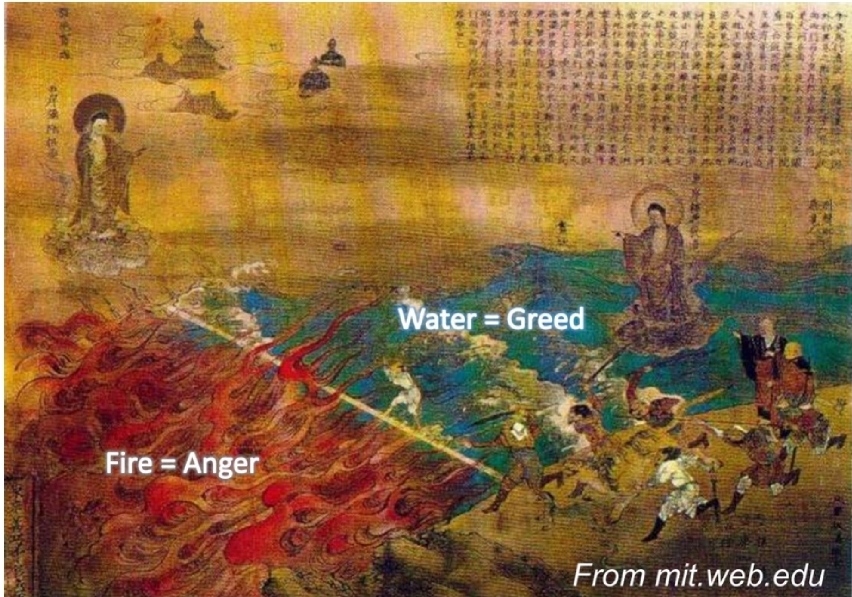Two Rivers and the White Path
 I hope everyone is well and healthy. I am looking forward to seeing everyone back at the temple one day. I would like to share a story of 'Two rivers and the White Path. This is a parable which appears in “The Commentary on the Contemplation Sutra” by Chinese Buddhist monk, and one of seven masters of the Pure Land School, namely Shan-tao (Zendo in Japanese) (613-681). It illustrates how an aspirant for the Pure Land awakens faith in Amida and attains birth in the Pure Land. The summary of the story goes like this …. “A man was traveling to the west. In the wilderness, he was pursued by bandits and fierce animals and came to a place where two rivers met. One was a river of fire which flowed to the south. The other, was a river of water which flowed to the north. These two rivers were a hundred paces wide but endlessly long. Where they met, there was a narrow white path, about 12 cm wide, leading to the west bank. As fire was raging on one side and water was violently raging, on the path, from the other, he hesitated to take the path, but since death, otherwise, appeared imminent, he decided to go forward on this narrow path. Just then, he heard a voice from the eastern bank, urging him to go forward across the path, and another voice from the western bank, calling him to come across. He was encouraged by these voices, and carefully proceeded along the path, and with determination soon reached the western bank, where he enjoyed leisure and eternal bliss.” The river of fire symbolizes anger, and that of water, symbolizes greed. The white path symbolizes the slim possibility of awakening faith in a mind full of evil passions. The voice from the eastern bank is the Teachings of Shakyamuni Buddha, and that from the western bank, the calling voice of Amida Buddha. The western bank represents the realm of the Pure Land. This parable became very popular, and together with the painting which depicts it, has been widely used to explain the Pure Land teaching. I can see the sense of urgency that Shan Tao's imagery brings to the story. This is not about just sitting around, passively reciting the Nembutsu. This is about a path of life to which we devote our whole being. Because of this, the insights of the story can apply to all Buddhists, regardless of their school or sect, on the importance of diligently pursuing their chosen path . Namo Amida Butsu Tatsuya Aoki
I hope everyone is well and healthy. I am looking forward to seeing everyone back at the temple one day. I would like to share a story of 'Two rivers and the White Path. This is a parable which appears in “The Commentary on the Contemplation Sutra” by Chinese Buddhist monk, and one of seven masters of the Pure Land School, namely Shan-tao (Zendo in Japanese) (613-681). It illustrates how an aspirant for the Pure Land awakens faith in Amida and attains birth in the Pure Land. The summary of the story goes like this …. “A man was traveling to the west. In the wilderness, he was pursued by bandits and fierce animals and came to a place where two rivers met. One was a river of fire which flowed to the south. The other, was a river of water which flowed to the north. These two rivers were a hundred paces wide but endlessly long. Where they met, there was a narrow white path, about 12 cm wide, leading to the west bank. As fire was raging on one side and water was violently raging, on the path, from the other, he hesitated to take the path, but since death, otherwise, appeared imminent, he decided to go forward on this narrow path. Just then, he heard a voice from the eastern bank, urging him to go forward across the path, and another voice from the western bank, calling him to come across. He was encouraged by these voices, and carefully proceeded along the path, and with determination soon reached the western bank, where he enjoyed leisure and eternal bliss.” The river of fire symbolizes anger, and that of water, symbolizes greed. The white path symbolizes the slim possibility of awakening faith in a mind full of evil passions. The voice from the eastern bank is the Teachings of Shakyamuni Buddha, and that from the western bank, the calling voice of Amida Buddha. The western bank represents the realm of the Pure Land. This parable became very popular, and together with the painting which depicts it, has been widely used to explain the Pure Land teaching. I can see the sense of urgency that Shan Tao's imagery brings to the story. This is not about just sitting around, passively reciting the Nembutsu. This is about a path of life to which we devote our whole being. Because of this, the insights of the story can apply to all Buddhists, regardless of their school or sect, on the importance of diligently pursuing their chosen path . Namo Amida Butsu Tatsuya Aoki
Design by WeebPal.





